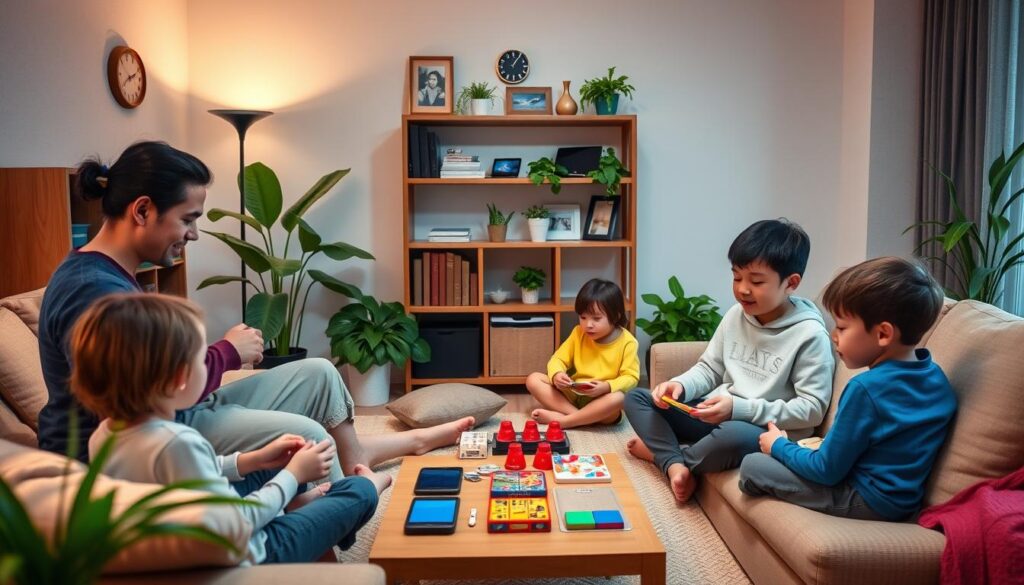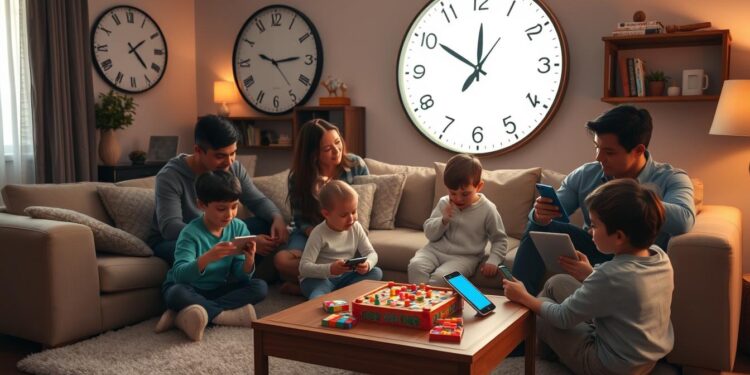In the digital age, managing kids’ screen time has become a pressing concern for parents. With screens permeating every aspect of our lives, from smartphones and tablets to computers and TVs, finding the right balance can feel like a constant challenge. But what if there was a way to harness the benefits of technology while mitigating its potential drawbacks? Could your family find a healthy, sustainable approach to screen time?
Key Takeaways
- Understand the different types of screen time activities and their potential impacts on your child’s development.
- Establish clear family rules and routines to help your kids develop healthy digital habits.
- Explore strategies for smooth transitions and offering age-appropriate screen time choices.
- Learn how to teach digital literacy and online safety to empower your children.
- Discover ways to set a positive example as a parent and model balanced screen time behavior.
What is Screen Time?
Screen time refers to the amount of time children spend interacting with digital devices, such as smartphones, tablets, computers, and televisions. These screens can be used for a variety of purposes, including homework, education, communication, entertainment, and leisure activities. Navigating and categorizing screen time can be challenging due to the diverse ways it is integrated into children’s lives.
Definition and Types of Screen Time Activities
Screen time encompasses a wide range of digital media and activities, including:
- Watching videos or movies
- Playing video games
- Browsing social media
- Using educational apps and websites
- Streaming content
- Engaging in online communication (e.g., video calls, messaging)
These screen-based activities can provide valuable learning opportunities and entertainment for children, but they must be balanced with other non-screen-based activities to promote a healthy lifestyle.
| Screen Time Statistic | Value |
|---|---|
| Screen time and digital technology use can be part of a healthy lifestyle when balanced with other activities for children aged 3-11 years. | N/A |
| Adults use screens for approximately nine hours daily, which is the same amount of time teenagers spend on screens. | 9 hours |
| Recommended recreational screen time for children ranges from one to two hours per day. | 1-2 hours |
| Nearly 90% of cell phone users keep their phones within reach 24 hours a day. | 90% |
“Family rules can help manage screen time and set limits and expectations for children regarding screen time and digital technology use.”
The Importance of Managing Screen Time
While digital devices and screen-based activities can offer educational and entertainment benefits, excessive or unstructured screen time can have a significant impact on a child’s development. Recognizing the importance of managing screen time is crucial for parents and caregivers to ensure a healthy balance in their children’s lives.
Potential Negative Effects of Excessive Screen Time
Prolonged screen time can lead to a range of negative consequences, including:
- Physical health issues: Increased risk of obesity, poor sleep patterns, and reduced physical activity.
- Mental health challenges: Behavioral problems, attention deficits, and delayed language and social skills development.
- Reduced learning and development: Less time for unstructured play, exploration, and valuable learning experiences.
The American Academy of Pediatrics emphasizes the need to actively manage children’s screen time to mitigate these potential negative effects and promote a healthy, well-rounded childhood.
“Excessive screen time can have a detrimental impact on a child’s physical, mental, and social well-being. As parents, it’s our responsibility to ensure a balanced approach to digital technology use.”
By establishing clear guidelines, fostering healthy habits, and encouraging alternative activities, parents can help their children develop a positive relationship with technology and maintain a healthy balance in their lives.

Establishing Family Rules for Screen Time
Establishing clear family rules and guidelines around screen time can help children understand the limits and expectations. This process involves setting guidelines for screen time hours, determining when and where digital technology can be used, and agreeing on appropriate use. It’s essential to involve all family members in creating these rules and to revisit them regularly as needs and interests change.
When negotiating screen time limits with your children, consider the following strategies:
- Create a screen time agreement that outlines the family’s screen time guidelines, including designated screen-free zones and times.
- Establish a consistent daily or weekly screen time limit based on your child’s age and developmental needs.
- Discuss the reasons behind the screen time rules and involve your children in the decision-making process.
- Encourage your children to suggest ideas for family rules for screen time that work for everyone.
- Be prepared to adjust the rules as your children grow and their needs change.
By involving your children in creating and revisiting the screen time guidelines, you can foster a sense of ownership and responsibility, making it easier to implement and maintain the rules over time.
“Managing screen time is not about being the ‘screen police,’ but rather about helping your children develop healthy habits and balance in their lives.”
Remember, the key to successful family rules for screen time is to be flexible, collaborative, and open to adjusting the guidelines as needed. With a thoughtful approach, you can help your children develop a healthy relationship with digital technology.
Developing Routines and Transitions
Establishing screen time routines is crucial for integrating digital technology into your family’s daily life in a balanced way. These routines can include designating specific times for screen time, such as a set period each day or after completing homework. Transitioning between screen time and other activities can be challenging for children, so strategies like providing warnings, allowing time to save progress, and offering choices can help make the transitions smoother.
Strategies for Smooth Transitions
Creating consistent routines for daily transitions can have significant benefits for your children. Visual cues, such as timers or countdown clocks, can greatly assist some children in understanding when screen time is ending. Rewards can also be an effective way to encourage positive transitioning behavior.
For children with ADHD, anxiety, autism, or sensory processing issues, scaffolding strategies are particularly important. Implementing appropriate consequences, while also praising good transitioning with specific feedback, can help manage difficult transitions.
Different strategies, like creating routines, using previews and countdowns, and giving attention and rewards, can significantly aid in easing transitions for children in various situations. By incorporating these techniques, you can help your kids smoothly transition from screen time to other activities, fostering a healthier relationship with digital technology.
| Strategy | Description |
|---|---|
| Routines | Establishing consistent daily routines for screen time can provide comfort and security for children, minimizing negative reactions when screens are turned off. |
| Visual Cues | Using timers, countdown clocks, or other visual aids can help children understand when screen time is ending, promoting a smoother transition. |
| Rewards | Offering rewards for positive transitioning behavior can encourage children to cooperate during the transition process. |
| Scaffolding | Providing additional support and strategies for children with special needs, such as ADHD, anxiety, or autism, can significantly aid in easing transitions. |
| Consequences and Praise | Implementing appropriate consequences for difficult transitions, while also providing specific praise for good transitioning, can help manage the process effectively. |

“Consistent routines for daily transitions can have significant benefits for children.”
Offering Choices and Encouraging Quality Content
As a parent, you play a crucial role in managing your children’s screen time and ensuring they engage with high-quality, educational digital content. By giving them choices and involving them in the decision-making process, you can increase their cooperation and foster a positive relationship with technology.
While the average American child spends over 7 hours a day on screens, the American Academy of Pediatrics recommends more reasonable limits: infants (0-2 years) should have no screen time except for video chatting; children (2-12 years) should limit screen time to one hour daily, with co-viewing encouraged; and teens and adults should limit screen time to two hours per day. The Australian Department of Health also recommends no more than one hour of screen time per day for children aged 2-5 years.
To help your children make the most of their screen time, consider offering them choices between age-appropriate, educational apps and media. Specific high-quality options include PBS Kids, Sesame Street, and National Geographic Kids. Encourage them to engage in co-viewing and co-playing activities, which can promote healthy screen use and learning.
Additionally, tools like Mobicip’s parental control features, including content filtering, time limits, and activity tracking, can assist you in managing your children’s screen time and ensuring they interact with appropriate digital content. The Mobicip Screen Time Scheduler allows you to set schedules for various activities and block specific apps and websites.
To further support your children’s digital literacy and online safety, consider recommending resources such as Common Sense Media, NetSmartz, and MediaSmarts. These platforms offer valuable information and guidance on navigating the digital world responsibly.
By giving your children choices, encouraging quality screen time activities, and providing the necessary tools and resources, you can help them develop a healthy relationship with technology and ensure their digital experiences are both engaging and educational.
| Screen Time Recommendation | Age Group | Recommended Limit |
|---|---|---|
| American Academy of Pediatrics | Infants (0-2 years) | No screen time except for video chatting |
| American Academy of Pediatrics | Children (2-12 years) | 1 hour daily, with co-viewing encouraged |
| American Academy of Pediatrics | Teens and adults | 2 hours per day |
| Australian Department of Health | Children (2-5 years) | No more than 1 hour per day |
“Quality matters more than quantity when it comes to screen time for kids.”
Managing Kids’ Screen Time: Practical Tips
Age-Appropriate Guidelines and Recommendations
Navigating the ever-evolving digital landscape can be a challenge for parents, but with the right strategies, you can help your children develop a healthy relationship with screens. The American Academy of Pediatrics provides clear age-appropriate guidelines to ensure your child’s screen time is balanced and beneficial.
For children under 18 months, the recommendation is to avoid screen time altogether, except for occasional video chatting. Between 18-24 months, the focus should be on high-quality content, with limited solo media use. As your child reaches ages 2-5, the recommendation is to limit screen time to one hour per day of educational and age-appropriate programming.
As your child grows, it’s essential to adjust your approach and consider the quality and purpose of the screen time, not just the quantity. Engaging with your child during screen time activities, discussing the content, and encouraging a balanced lifestyle that includes other activities can help ensure a positive and constructive relationship with digital technology.
| Age Group | Recommended Daily Screen Time Limits |
|---|---|
| Infants (0-18 months) | No screen time, except for video chatting |
| Toddlers (18-24 months) | Limited to high-quality content, avoid solo media use |
| Preschoolers (2-5 years) | 1 hour of educational and age-appropriate programming |
| School-age Children (6-11 years) | 2 hours of balanced, quality content |
By following these age-appropriate guidelines and incorporating practical tips for managing screen time, you can help your children develop a healthy and balanced relationship with digital technology.
Teaching Digital Literacy and Online Safety
As children navigate the digital landscape, it’s crucial to equip them with the skills to become digitally literate and stay safe online. Digital literacy for kids involves teaching them how to identify trustworthy information, understand the purpose of advertising, and think critically about the media they consume. This empowers children to make informed decisions and develop a responsible digital behavior.
One of the key aspects of online safety education is discussing appropriate online conduct. Parents should guide their children on what information is appropriate to share or post, and what should be kept private. By fostering an understanding of responsible digital behavior, children can learn to navigate the digital world safely and responsibly.
Encouraging critical thinking about media is another important aspect of digital literacy. Children should be taught to question the reliability of online sources, recognize biases, and understand the motivations behind various digital content. This critical thinking skill will serve them well as they continue to explore the vast and ever-changing digital landscape.
Ultimately, teaching digital literacy and online safety is essential in preparing children for the digital future. By equipping them with the right tools and mindset, parents can empower their kids to become responsible and savvy digital citizens.
“The future belongs to those who understand how to navigate the digital world and use technology responsibly.” – Anonymous
Setting a Positive Example as a Parent
As a parent, your role in modeling healthy screen time habits is crucial for your children’s well-being. By demonstrating responsible technology use, you can help your kids develop positive digital behaviors that will serve them well throughout their lives.
Modeling Healthy Screen Time Habits
Start by setting boundaries around your own device usage. Avoid excessive screen time and engage in tech-free activities with your family. When you’re with your children, be present and avoid the temptation to constantly check your phone or tablet. This sends a powerful message that you value face-to-face interactions and quality time together.
Involve your children in developing family technology agreements. Collaborate with them to establish reasonable screen time limits, create tech-free zones in your home, and identify appropriate online content. By working together, you can foster a sense of shared responsibility and ensure that the rules are fair and practical.
Remember, your children are always observing your actions. If you model healthy screen time habits, they’re more likely to adopt similar behaviors. Encourage them to participate in offline hobbies, physical exercise, and social activities that don’t revolve around technology. This balanced approach will help your kids develop a healthy relationship with digital devices.
“The greatest gift you can give your child is your presence.” – Thich Nhat Hanh
By setting a positive example as a parent, you can empower your children to navigate the digital world with confidence and care. Embrace the opportunity to guide them towards a balanced, technology-savvy lifestyle that prioritizes personal connections and meaningful experiences.
Conclusion
Managing kids’ screen time is a significant challenge for parents in the digital age, but it is essential for promoting healthy child development. By establishing family rules, developing routines, offering choices, teaching digital literacy, and setting a positive example, parents can help their children find a balanced approach to screen time and technology use. The key is to empower families to navigate the digital landscape in a way that supports children’s physical, mental, and social well-being.
The summary of key tips includes setting daily or weekly screen time limits, creating tech-free zones, monitoring online behavior, and encouraging quality content. Striking a balance between the benefits and potential drawbacks of technology is crucial, as excessive and unsupervised screen time can hinder a child’s intellectual development and academic performance. Empowering parents to manage screen time effectively is the ultimate goal, ensuring that technology enhances, rather than detracts from, a child’s overall well-being.
By following the guidelines and recommendations outlined in this article, parents in Australia can take proactive steps to regain control over their children’s screen time and foster a healthy, balanced relationship with technology. With consistent effort and a focus on establishing routines and setting positive examples, families can navigate the digital age with confidence and support their children’s growth and development.

